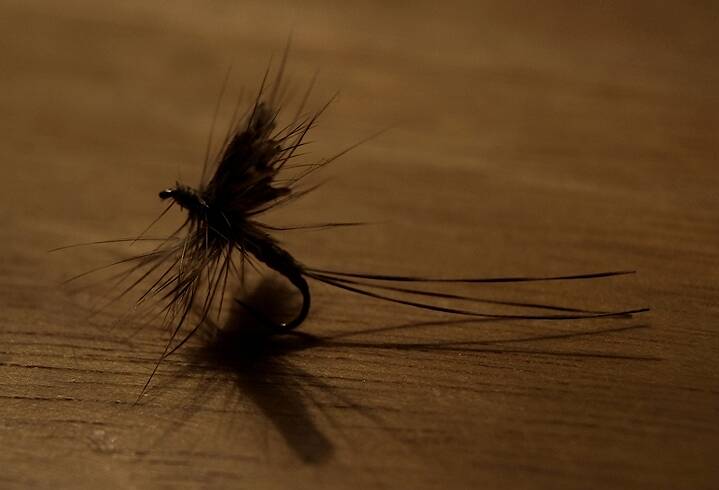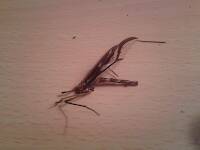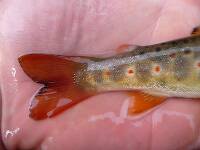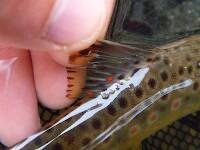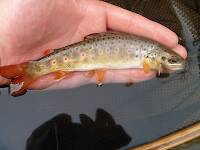
Hex Mayflies
Hexagenia limbata
The famous nocturnal Hex hatch of the Midwest (and a few other lucky locations) stirs to the surface mythically large brown trout that only touch streamers for the rest of the year.
Featured on the forum

I was not fishing, but happened to be at an unrelated social event on a hill above this tiny creek (which I never even saw) when this stonefly flew by me. I assume it came from there. Some key characteristics are tricky to follow, but process of elimination ultimately led me to Sweltsa borealis. It is reassuringly similar to this specimen posted by Bob Newell years ago. It is also so strikingly similar to this nymph from the same river system that I'm comfortable identifying that nymph from this adult. I was especially pleased with the closeup photo of four mites parasitizing this one.

Troutnut is a project started in 2003 by salmonid ecologist Jason "Troutnut" Neuswanger to help anglers and
fly tyers unabashedly embrace the entomological side of the sport. Learn more about Troutnut or
support the project for an enhanced experience here.
FisherOfMen on Jan 2, 2012January 2nd, 2012, 5:31 pm EST
I fish in Little River, NY plenty during the year. What makes this trout flow different is the large amount of tannin in the water, making it very dark in all but the brightest sunlight. I can't see bottom in more than 1 1/2 ft. even in full sun. I have several questions: Does the tannin inhibit the trout's vision as well? So can I be a little less sneaky?
Also, I've only caught two browns fly fishing there maybe ten or fifteen days this summer. I'm a beginner, but is it possible there just aren't but a few trout in a 1/2 mile stretch of river? I never see trout other than this same big brown feeding on the top when the Mayfly hatch is on. Any tips for dark water?
I'm just beginning, so anything will help - thanks!
Also, I've only caught two browns fly fishing there maybe ten or fifteen days this summer. I'm a beginner, but is it possible there just aren't but a few trout in a 1/2 mile stretch of river? I never see trout other than this same big brown feeding on the top when the Mayfly hatch is on. Any tips for dark water?
I'm just beginning, so anything will help - thanks!
"Nothing makes a fish bigger than almost being caught." -Author Unknown
All that is necessary for the triumph of evil is that good men do nothing. -Edmund Burke
All that is necessary for the triumph of evil is that good men do nothing. -Edmund Burke
Strmanglr on Jan 4, 2012January 4th, 2012, 11:23 am EST
My best advice would be watch your step! Dark water and not being able to see the bottom makes me an incredibly slow wader.
I would say vibration and sighting are two of the biggest indicators to a fish to be scared. As far as the fish seeing you less, I would personally think yes to a point. However, you are basically a big tree moving around fish. How much does the fish need to see to get spooked?
Have you caught any fish other than trout? If there is a big one feeding then the stream is more than likely getting carryover from year to year from planted fish or there is natural reproduction going on. Either way the "big one" is a good sign.
I would say vibration and sighting are two of the biggest indicators to a fish to be scared. As far as the fish seeing you less, I would personally think yes to a point. However, you are basically a big tree moving around fish. How much does the fish need to see to get spooked?
Have you caught any fish other than trout? If there is a big one feeding then the stream is more than likely getting carryover from year to year from planted fish or there is natural reproduction going on. Either way the "big one" is a good sign.
PaulRoberts on Jan 4, 2012January 4th, 2012, 1:35 pm EST
Talk to your DEC biologist. I've found them very willing to share info.
Lotsa tannins will likely mean acidic water, which in turn is likely low in available nutrients. There may be few trout per unit area there. Again, talk to your local biologist for the scoop.
Lotsa tannins will likely mean acidic water, which in turn is likely low in available nutrients. There may be few trout per unit area there. Again, talk to your local biologist for the scoop.
FisherOfMen on Jan 7, 2012January 7th, 2012, 2:35 pm EST
I also wade very slow, even with a staff. I took a spill last year and landed with my knee right on the crown of a boulder. I've been very, very careful since that day. Fly fishing is good fun, but a fall could ruin a great day in a second.
I guess I should've guessed as to how the trout might see me. Thanks - but something else - How stealthy do you have to be. In videos I've seen anglers sneaking up on browns to the extent of crawling on their bellies with great results, but I've also seen another angler take two big (and noisy) spills right before hooking the a nice catch of schooling brookies. Is just a slight crouch okay with light footsteps, or is it necessary at times to crawl on your hands and knees along a bank with tannin-stained waters?
Thanks for the Help!
I guess I should've guessed as to how the trout might see me. Thanks - but something else - How stealthy do you have to be. In videos I've seen anglers sneaking up on browns to the extent of crawling on their bellies with great results, but I've also seen another angler take two big (and noisy) spills right before hooking the a nice catch of schooling brookies. Is just a slight crouch okay with light footsteps, or is it necessary at times to crawl on your hands and knees along a bank with tannin-stained waters?
Thanks for the Help!
"Nothing makes a fish bigger than almost being caught." -Author Unknown
All that is necessary for the triumph of evil is that good men do nothing. -Edmund Burke
All that is necessary for the triumph of evil is that good men do nothing. -Edmund Burke
FisherOfMen on Jan 7, 2012January 7th, 2012, 2:36 pm EST
How might I find the contact information for a DEC biologist?
Thanks!
Thanks!
"Nothing makes a fish bigger than almost being caught." -Author Unknown
All that is necessary for the triumph of evil is that good men do nothing. -Edmund Burke
All that is necessary for the triumph of evil is that good men do nothing. -Edmund Burke
PaulRoberts on Jan 8, 2012January 8th, 2012, 4:32 am EST
All DNR's have a website and contact numbers. Or just call your regional office and inquire. I found NY was esp open.
How quiet? Depends... In flat water under bright conditions I may have to act downright paranoid as the that's the way the fish are. In broken water you may be able to get close relatively easily. If they are closer to a security zone -depths of a pool- it is harder to "spook them". If the fish don't associate disturbance with you you can get away with a certain amount. Wading above fish can roll substrate which puts bugs into the drift and can get fish feeding. Trout have a blind spot directly behind their heads. In broken water I've been able to approach slowly behind being careful not to trip their "burglar alarm sensors":
-lateral line/feel: by moving slowly enough not to push a pressure wake that exceeds current speed,
-eyes" by staying low below "Snell's Window" (which is a fairly flat plane in shallow water) and taking advantage of the blind spot. Doing this I've layed down against the very boulder trout are feeding immediately above, my face a mere 3 feet from them happily feeding fish. How cool is that!
In general, if a trout is up in skinny water, away from its safety zone, it may freak at the slightest disturbance. Fish are VERY perceptive, if conditions allow. Streams are generally the easiest waters to approach fish in. But still a large amount of stealth is required to catch them. In fact, RULE$1 is -Don't spook em!"
One of the best pieces of advice I could give any angler would be to relax, back off on the run-n-gun, and observe. You'll learn more from patient observation than you will otherwise. I've watched anglers approach pools of feeding trout many times and almost to a man they put the majority of fish down before those happily feeding fish even see the fly.
You can also wait fish out. Usually, trout will resume feeding after a short while. They can get used/de-sensitized to your presence even –to a point.
Here’s a trip report I wrote up that gives a play by play in which stealth weighed in:
http://www.troutnut.com/topic/2421/Recipe-Stealth-patience-and-NO-micro-drag
How quiet? Depends... In flat water under bright conditions I may have to act downright paranoid as the that's the way the fish are. In broken water you may be able to get close relatively easily. If they are closer to a security zone -depths of a pool- it is harder to "spook them". If the fish don't associate disturbance with you you can get away with a certain amount. Wading above fish can roll substrate which puts bugs into the drift and can get fish feeding. Trout have a blind spot directly behind their heads. In broken water I've been able to approach slowly behind being careful not to trip their "burglar alarm sensors":
-lateral line/feel: by moving slowly enough not to push a pressure wake that exceeds current speed,
-eyes" by staying low below "Snell's Window" (which is a fairly flat plane in shallow water) and taking advantage of the blind spot. Doing this I've layed down against the very boulder trout are feeding immediately above, my face a mere 3 feet from them happily feeding fish. How cool is that!
In general, if a trout is up in skinny water, away from its safety zone, it may freak at the slightest disturbance. Fish are VERY perceptive, if conditions allow. Streams are generally the easiest waters to approach fish in. But still a large amount of stealth is required to catch them. In fact, RULE$1 is -Don't spook em!"
One of the best pieces of advice I could give any angler would be to relax, back off on the run-n-gun, and observe. You'll learn more from patient observation than you will otherwise. I've watched anglers approach pools of feeding trout many times and almost to a man they put the majority of fish down before those happily feeding fish even see the fly.
You can also wait fish out. Usually, trout will resume feeding after a short while. They can get used/de-sensitized to your presence even –to a point.
Here’s a trip report I wrote up that gives a play by play in which stealth weighed in:
http://www.troutnut.com/topic/2421/Recipe-Stealth-patience-and-NO-micro-drag
Oldredbarn on Jan 9, 2012January 9th, 2012, 10:15 am EST
One of the best pieces of advice I could give any angler would be to relax, back off on the run-n-gun, and observe. You'll learn more from patient observation than you will otherwise. I've watched anglers approach pools of feeding trout many times and almost to a man they put the majority of fish down before those happily feeding fish even see the fly.
Well put Paul! On the Au Sable I sometimes wonder where everyone's going in such a rush. Maybe the old human watering hole? :) They just trod right on through like they have an appointment further downstream or something. In reality, they miss so much.
I have run in to rather accomplished angler's from elsewhere that have asked me about why it is that most of the angler's on the Au Sable seem to prefer to fish downstream...I really don't have a good answer for them.
I don't know the absolute truth of the following, but I was told that the locals up there got a kick out of Marinaro and his buddies years ago when they visited the Au Sable...See, "In the Ring of the Rise". I heard that Vince et al were seen sitting in the woods a few feet from the stream watching for risers...So the story goes, they were nicknamed the Wood Fairies.
Rusty fished this way in the evening. The idea is to let everything settle out and let the big boys feel like its ok to feed...Then you plan your attack. Splashing around in the stream only spooks the larger, "wiser", fish. The only problem is, not eveyone got the memo...I have sat with him and we waited for "The Feed" only to have other anglers march right on by in the river. This may have helped with the tradition up there of fishing later in to the dark (Not that Brown Drakes, Gray Drakes, Iso's, and Hex didn't do their part :))...Sooner or later some of these guys head for home. You just have to wait them out.
Spence
"Even when my best efforts fail it's a satisfying challenge, and that, after all, is the essence of fly fishing." -Chauncy Lively
"Envy not the man who lives beside the river, but the man the river flows through." Joseph T Heywood
"Envy not the man who lives beside the river, but the man the river flows through." Joseph T Heywood
PaulRoberts on Jan 9, 2012January 9th, 2012, 3:55 pm EST
Interesting, Spence. Most of my waters never had a parade on them. I can see what you are saying from the trout's, and savvy angler's, perspective.
You don't really have to think like a fish -impossible really -but it sure helps NOT to think like the rest of the crowd.
You don't really have to think like a fish -impossible really -but it sure helps NOT to think like the rest of the crowd.
Oldredbarn on Jan 10, 2012January 10th, 2012, 10:21 am EST
Interesting, Spence. Most of my waters never had a parade on them.
Paul...Must be nice!
The old Au Sable is a pretty famous stretch of water and gets its fair share and then some of traffic. The nice thing about "home waters" is that you get to really know them after years of fishing them. You know where the nicer fishing may be, where the road less travelled might be (the...you need to get away from access sites rule), and when and where the canoe traffic is a problem during different parts of the day. I can't prove it, but I think that sometimes all this commotion the fish become acclimated to...To a degree. They have to eat after all. :)
I know we are dealing with a creature with a pea-sized brain that's "long-term memory" is in question.:) On my river though, it seems that over time the bigger Browns have evolved to be extremely adept at hiding along the edges, under instream structure, over-hanging shrubs,under-cut banks, and seldom venture away from these places until after the sun sets and some of the frenzy dials down a bit or later in the year when spawnings the number one thing on that pea-brain.
It is difficult to say whether or not these fish have habits formed from dealing for years with all that traffic or not, but it seems so. A good angler with a little predator in him will figure all this out and approach his quarry with this in mind...Or be satisfied with the dinks out in the river who are themselves afraid to wander to close to those edges...:)
Spence
"Even when my best efforts fail it's a satisfying challenge, and that, after all, is the essence of fly fishing." -Chauncy Lively
"Envy not the man who lives beside the river, but the man the river flows through." Joseph T Heywood
"Envy not the man who lives beside the river, but the man the river flows through." Joseph T Heywood
PaulRoberts on Jan 11, 2012January 11th, 2012, 7:30 am EST
It is nice, but I've had my share of pressured fish, esp on steelhead waters. Whereever there are big trout there are likely to be anglers. Although it can be fun to work between the crowds, I shy away more and more now, and look for the obscure areas where a few big fish might eek out a living.
I agree that trout can acclimate to anglers being about, both short term and long term. As you say, they have to eat. Trout are all about food and if conditions are right, they are on it. On a big emergence, we've all had fish rise all around us. And on some really popular tailwaters I've read that trout will use anglers as current breaks to feed off of.
On the flip-side, in remote high country areas I've fished that had never seen anglers, cutts and brookies can be pricked -repeatedly- and still try to eat the same fly! They are completely naive. There are species diffs too -overall spookiness and what pushes their buttons. I do wonder what completely naive browns would be like. I suppose stockies are the closest I've come to that, and they are very diff from edified fish, but still, I cannot prick them more than once.
As to big brown location, what you describe sounds like it could be one (or more) of three things:
1) Energy budgets -mature fish being MUCH stingier with their energy expenditure compared to younger ones.
2). Habitat, and food type (linked to energy budgets). On smaller and/or less productive waters, big trout (browns esp) may be piscivorous and spend much of their hours in sanctuaries. On the large productive waters I've fished big browns may be found almost anywhere, although we often got away from the easy access spots to avoid competition/pressure. And it did appear that there were more big trout in out of the way spots -although I don't know if that was just habitat and/or the excitement of exploration. Would like to hear Matt’s (WB’s) comments on that.
3). Direct mortality, where catch and kill pressure s heavy -simple survival. I've seen on the most popular steelhead rivers, where they’d literally have to run a gauntlet of anglers and snaggers, fish would collect in areas of respite –sometimes odd places.
I agree that trout can acclimate to anglers being about, both short term and long term. As you say, they have to eat. Trout are all about food and if conditions are right, they are on it. On a big emergence, we've all had fish rise all around us. And on some really popular tailwaters I've read that trout will use anglers as current breaks to feed off of.
On the flip-side, in remote high country areas I've fished that had never seen anglers, cutts and brookies can be pricked -repeatedly- and still try to eat the same fly! They are completely naive. There are species diffs too -overall spookiness and what pushes their buttons. I do wonder what completely naive browns would be like. I suppose stockies are the closest I've come to that, and they are very diff from edified fish, but still, I cannot prick them more than once.
As to big brown location, what you describe sounds like it could be one (or more) of three things:
1) Energy budgets -mature fish being MUCH stingier with their energy expenditure compared to younger ones.
2). Habitat, and food type (linked to energy budgets). On smaller and/or less productive waters, big trout (browns esp) may be piscivorous and spend much of their hours in sanctuaries. On the large productive waters I've fished big browns may be found almost anywhere, although we often got away from the easy access spots to avoid competition/pressure. And it did appear that there were more big trout in out of the way spots -although I don't know if that was just habitat and/or the excitement of exploration. Would like to hear Matt’s (WB’s) comments on that.
3). Direct mortality, where catch and kill pressure s heavy -simple survival. I've seen on the most popular steelhead rivers, where they’d literally have to run a gauntlet of anglers and snaggers, fish would collect in areas of respite –sometimes odd places.
Strmanglr on Jan 11, 2012January 11th, 2012, 7:45 am EST
When you learn holding spots for fish and be able to read the river well, you'll know when you can move fast and when you want to be stealthy. The hard part about that is you never really know where every spot a fish will hold and they'll surprise you sometimes in spots you never would have thought they would be. I've amazed myself before and flushed fish out of spots. That's part of what draws me to stream fishing. It's more than fishing, it's hunting too.
I fish upstream as much as I can. The fish are facing up current and I feel I have an advantage that way. I fish small water though, fish something big like the Au Sable and It's much easier to fish down stream imo, cause you can fish the other side of the river and in general you can get your cast farther away from yourself. I'll post the question of up or down. See what we get.
I fish upstream as much as I can. The fish are facing up current and I feel I have an advantage that way. I fish small water though, fish something big like the Au Sable and It's much easier to fish down stream imo, cause you can fish the other side of the river and in general you can get your cast farther away from yourself. I'll post the question of up or down. See what we get.
Oldredbarn on Jan 11, 2012January 11th, 2012, 10:01 am EST
I do wonder what completely naive browns would be like.
Not as much fun Paul, no doubt! :)
The stretches I'm usually fishing are in the catch-and-release areas of the Au Sable, but I agree with everything you wrote there. If an old Brown can find a reliable food spot and its somewhere he doesn't have to work too hard to maintain...He's in paradise!
I had a friend's father tell me once that the largest Brown he ever caught on the Au Sable was barely covered. The spot he had found was so shallow.
I've amazed myself before and flushed fish out of spots.
Strmanglr...It is funny to me that you bring this up...A friend and I were talking yesterday about a local stocked river and he told me a story about a time in the summer when he was just knocking around over there for fun. He was up high and spotted two spin fishermen in shorts and sneakers and they were crawling over a large wood pile in the river. They didn't notice it at all but they spooked what he estimated as a 28" Brown from under this pile...He said that the fish probably hung under there all day and only came out at night and it raced around the pool acting like it wasn't sure of what it should do. The guys on the pile never saw it...:)
Spooking good fish is a very good reason for keeping a streamside log...:) This Altschuler doesn't own a GPS unit...
I used to walk the river with an old friend that other old friends would say that he fished like a Great Blue Heron...Stealth has its place. Occasionally he would stop and stare at a particular spot. I would mark it in my mind...Sometimes, if he was in a good mood, he'd say that I should never walk by a spot without stopping and checking it out and seeing if Mr. Big was feeding that day. :)
I have guide friends that know where some of the larger fish live and they speak among themselves about when one of their clients may have hooked him last. They do this to not over stress this fish. I wonder sometimes just how much stress gets put on some of these fish in a river that gets pressured.
One of the side line hobbies of my fly fishing over the years is an interest in birds. I went out last weekend with one of the local Audubon groups for their winter bird count. We are in what is called an irruptive year and there have been some Great Grays and Snowy owls that have been spotted nearby. There is a Great Gray over in Ontario near Detroit here and some of the folks at the bird count were going over to hunt it down. I found a YouTube of this bird that someone has posted...The bird is sitting in a low tree and the person filming it panned around to show nearly 30+ folks standing there watching this poor bird with $3,000 spotting scopes, cameras, etc...The bird didn't seem bothered, but again I wonder what sort of pressure we are putting on these creatures with our new technology.
Spence
"Even when my best efforts fail it's a satisfying challenge, and that, after all, is the essence of fly fishing." -Chauncy Lively
"Envy not the man who lives beside the river, but the man the river flows through." Joseph T Heywood
"Envy not the man who lives beside the river, but the man the river flows through." Joseph T Heywood
Entoman on Jan 11, 2012January 11th, 2012, 7:35 pm EST
Interesting comments guys,
As a rule I've found back country trout more wary of wading than the frauds we throw at them, while the opposite is true of pressured waters.
As a rule I've found back country trout more wary of wading than the frauds we throw at them, while the opposite is true of pressured waters.
"It's not that I find fishing so important, it's just that I find all other endeavors of Man equally unimportant... And not nearly as much fun!" Robert Traver, Anatomy of a Fisherman
PaulRoberts on Jan 12, 2012January 12th, 2012, 7:30 am EST
As a rule I've found back country trout more wary of wading than the frauds we throw at them, while the opposite is true of pressured waters.
Hmmmm... Interesting. I'll have to keep that in mind next time I'm up there. Something to play around with.
I'd say shallow trout, away from sanctuary, are spooky -period. So...small streams tend to be full of spooky trout.
On pressured water (or anywhere) fish moving up to feed in skinny head riffs, or stream banks, are also VERY spooky. Add flat water and they can be almost impossible to approach.
But the deeper areas, out of sight, I suppose, can be approached easier -esp if there's some broken water to help mask movement, sound, and especially pressure waves.
Most animals have several alarm sensors: usually sight, scent, sound, touch. which exist in a hierarchical arrangement of importance that varies by species, prior sensitization/state of alarm, and existing environmental conditions. For many creatures/circumstances, only one alarm need be tripped to send them fleeing. But other times the stimulus may require further assessment, bc running away devours energy. In unspooked whitetail deer for instance, an out of place sound or image will most often cause them to freeze to gain further info. Often it takes two senses, the ears and eyes, to maker a decision. As a predator, it’s easier to get away with tripping one sensor on your prey, but not two. With deer though, the nose trumps all. Mule deer are more visual than whitetails, being much quicker to trust their eyes.
Fish have multiple alarm sensors too, and a hierarchical arrangement of importance too. However, fish have an expanded tactile system via hair cells (lateral line is part of this system), and some have electro-receptive capabilities –the ability to detect slight changes in electric fields. So, when throwing flies to electroreceptive bullheads and catfish we are simply speaking the wrong language, although channel cats are much more visual and more apt to be duped by artificials.
For carp it’s hearing/touch, taste/smell, and sight in that order. As ostariophysids (like other minnows), they contain “Weberian ossicles”, bony structures attached to the inner ears which amplify sound. I found, in fly-fishing for them, that the sound of a leader or tippet “singing” in the water (produced in a rapid pick-up, or current over a sunken line) would put pods of carp down instantly. I’ve not seen this degree of sound sensitivity in any other fish.
For trout (and bass) I’d say it’s pressure waves, sound, then sight, for predator detection. But, when trout are vulnerable –shallow fish –tripping any one sense can cause them to flee. Scent is known to cause a powerful flight response in pacific salmon. They are sensitive to the scent of seals at amazingly minute concentrations. At one time a study isolated the amino acid L-Serine was showed to elicit fright reactions in fish. In-Fisherman magazine jumper on it and tested the palm secretions of its staff, and lo and behold Al Lindner was found to have one of the lowest L-Serine concentrations known! No wonder he catches SO many fish, eh? Over time though the original research was dis-credited, which leaves one to speculate whether L-Serine concentrations in human palm secretions aren’t a better indicator of ego than anything else.
I’ve come to realize just how sensitive shallow fish can be, in one instance by playing with a pod of trout in an outflow culvert of a hatchery I worked at, that contained some escapee's. The idea was to see how close I could approach. Seems easy enough. However, the area was surrounded by soggy ground -that carries sound/pressure waves remarkably easily. I could never get close., as the trout could feel the pressure wake created as my feet depressed the soft ground. The same is true along soggy pond edges; Try to approach shoreline hugging bluegills without them noticing! After the ground dries, it's much easier, and it’s their eyes especially you have to avoid.
Something that feels similar occurs when I’m hunting deer (or rabbits) on moist ground; Foot falls reverberate, esp if you kick a rock or root, and the sound carries; I swear it’s "felt", in the diaphragm. Deer and rabbits communicate by ground-thumping with hind feet, and it produces a low frequency “thump” I can feel in my diaphragm or in my gut. Grouse wings can do the same thing. Maybe it’s my adrenals (located on my kidneys) activating, but I always believed I could feel it. Regardless of origin, I’ve become sensitized to it. And when I feel it, I freeze.
Well… This one got me going. Welcome to my world ... where do fish stop and other critters begin?? Hope all this is at least interesting if not actually useful.
Entoman on Jan 12, 2012January 12th, 2012, 9:33 am EST
I think it's an adaptability thing as already mentioned. There are several famous waters where the fish are so used to wading anglers that they continue to work within feet of one who has just waded into position - usually after just a few minutes. Repetitive casting and lining usually doesn't intimidate them either. But man, are they expert at detecting micro-drag or imitations they've seen a lot!:)
Conversely, I've fished a lot of water that while similar in appearance (but receiving far less pressure), the fish scurry for cover at the slightest warning. The angler may have quite a long wait if the approach is blown. Once the fish settle down though, they are usually much easier to fool. Consistent with the theory, lining or excessive casting will usually put them down indefinitely.
Conversely, I've fished a lot of water that while similar in appearance (but receiving far less pressure), the fish scurry for cover at the slightest warning. The angler may have quite a long wait if the approach is blown. Once the fish settle down though, they are usually much easier to fool. Consistent with the theory, lining or excessive casting will usually put them down indefinitely.
"It's not that I find fishing so important, it's just that I find all other endeavors of Man equally unimportant... And not nearly as much fun!" Robert Traver, Anatomy of a Fisherman
Oldredbarn on Jan 12, 2012January 12th, 2012, 10:26 am EST
Something that feels similar occurs when I’m hunting deer (or rabbits) on moist ground; Foot falls reverberate, esp if you kick a rock or root, and the sound carries; I swear it’s "felt", in the diaphragm. Deer and rabbits communicate by ground-thumping with hind feet, and it produces a low frequency “thump” I can feel in my diaphragm or in my gut. Grouse wings can do the same thing. Maybe it’s my adrenals (located on my kidneys) activating, but I always believed I could feel it. Regardless of origin, I’ve become sensitized to it. And when I feel it, I freeze.
There's a primitive thread running through you there Paul. Hunter/hunted. Left over from way back no doubt.
I have this lovely little spot where I like to start some of my fishing days from. I park the car and hike a good distance through the woods upstream to an access point. Just above the path to the river is a nice hole known as the Brookie Hole...How many of those exist, eh? :)
Imagine a straight away 3/4th of a football field long where the river is running over gravel and is knee deep, give-or-take. Food factory. The last 1/4 of the football field the river deepens to just below hip deep in the deeper sections. Then the river opens up wide and shallow to go around an island at the access site.
The deeper last 1/4 is the Brookie Hole. I have sat there on downed trees stringing up the rod, scoping the place out, and planning my attack...Always watching The Hole! I have watched as fish fed there with the consistency of a metronome. Until I moved in any way in the direction of The Hole. Then the feeding stops.
I have done just about everything one could try to "sneak up" on The Hole. Sometimes I have said a little prayer that other anglers weren't watching because I may have had a difficult time explaining to them what the hell I was up to. :) I have noticed, as I stood along the edge, that the once calm, steady, relaxed feeding morphed in to rather quick smacks at passing bugs. It was like they knew I was standing there and they weren't going to let this chance at food pass.
If it wasn't for this spot being near an access site, something I avoid, I may never leave it. There is so much going on there that interests me about some of the subtleties of our sport. I have been known to obsess to a neurotic extent over these problems and difficult fish...There was a fish on the Madison in 1995 that drove me to the loonie bin and I have told few the truth about how much time I wasted there with that damn trout. :)
My old fishing buddy would yell at me to move on and find easier fish, but all these years later I think I'm a damn better angler for taking the time to learn something from these problem children.
We are walking in their world and they have had eons to hone their survival skills. The fish we talk about the most, made it to their size by not making too many mistakes...The ones I've been lucky enough to out wit I'll remember for the rest of my life! I don't really remember much about the thousands of sacrificial dolts in between. Frying pan fodder who's genes never make it to the next round...:)
Aside: The river was up a good deal last spring and I was surprised when I took a very nice Brown from the Brookie Hole...Maybe he had slid in there looking for Brook Trout too...;)
Spence
"Even when my best efforts fail it's a satisfying challenge, and that, after all, is the essence of fly fishing." -Chauncy Lively
"Envy not the man who lives beside the river, but the man the river flows through." Joseph T Heywood
"Envy not the man who lives beside the river, but the man the river flows through." Joseph T Heywood
Entoman on Jan 12, 2012January 12th, 2012, 9:19 pm EST
Hey Spence,
Based on your description, I think I found the run on Google maps. Hey, that looks like you standing in the river fishing! Ah, now I know why you really like the spot. Those are some interesting looking occupants in that canoe floating by behind you. Can't make out the faces, but you seem to be looking at them rather than your line in front of you... Does the missus read these? Hope I didn't out you.:)
Based on your description, I think I found the run on Google maps. Hey, that looks like you standing in the river fishing! Ah, now I know why you really like the spot. Those are some interesting looking occupants in that canoe floating by behind you. Can't make out the faces, but you seem to be looking at them rather than your line in front of you... Does the missus read these? Hope I didn't out you.:)
"It's not that I find fishing so important, it's just that I find all other endeavors of Man equally unimportant... And not nearly as much fun!" Robert Traver, Anatomy of a Fisherman
Oldredbarn on Jan 13, 2012January 13th, 2012, 5:06 am EST
Kurt,
Yeah! I think I remember that day...When the Google satelite went over it put down my fish...:)
In terms of the bikini clad herd that parades down the Au Sable...They are usually bundled up when I'm up there in May...That has been the plan. I have visited the river the same week in May since 1991...Memorial Day is the traditional "opening day" of what Rusty used to call the "Aluminus flotilla" hatch. I'm heading towards home as they are heading north. :)
The saving grace of the late spring/early summer fishing, say Brown Drakes on, is that one can do it after dark when the canoes are back in their racks for the day and the their drunken captains are sleeping it off.
The last few years though we have had unseasonably warm temps. A couple years back the water temps were creaping in to the low 70's during the warmest part of the day...Too stressful for the fish really. I can remember a week in the 90's when it snowed on me during this same week...I had a crystal blue sky and one spitting gray cloud over my head...I thought the "big guy" was trying to tell me something...:) "MOVE DOWNSTREAM YOU NIMROD! THE FISH ARE RISING DOWN THERE AND HERE YOU SIT! MOPING!"
My guide friend and I floated the South Branch that week and I remember him looking at me before we sat off and asking, "Are you sure about this Spence?! Once we start there's no turning back." The bag of ice I bought for the beer was still ice at the end of the day and this was before I had my back surguries and when we got to the end I was so bent over I looked like Quasimodo...My friend was so concerned he wouldn't let me help him with getting the boat on his trailer. He turned on the truck and its heater and had me sit in it and thaw back out...
The real sad thing about that cold gray day was, the only flies on the water the entire day were (& I know their names have changed) either Baetis cingulatus or Baetis pygmaeus...Hundreds of very, very, tiny slate-winged sail boats and no fish feeding on them...I call these little shits Baetis dinkus...and I'm being nice. At the halfway mark we stopped for lunch and I grabbed a couple beers for us and my friend said, "Spence. You got any hot chocolate?!" He wasn't joking.
I did manage to catch a really nice brook trout that day that, if we had measured it, may have made Rusty's Hog Chart...When I told this to Rusty the next day he asked if I had taken a picture of it...When I said no, "Too damn cold!", he said, "I'd fire my guide." :) I wasn't sure if he was joking or not...;)
Sometimes up there I revert back to the young boy I once was way back in the 60's and its more about the adventure than anything else...Cold. Who gives a shit?! We were on the river all damn day and never saw another soul...Paradeisos!!!
Spence
Yeah! I think I remember that day...When the Google satelite went over it put down my fish...:)
In terms of the bikini clad herd that parades down the Au Sable...They are usually bundled up when I'm up there in May...That has been the plan. I have visited the river the same week in May since 1991...Memorial Day is the traditional "opening day" of what Rusty used to call the "Aluminus flotilla" hatch. I'm heading towards home as they are heading north. :)
The saving grace of the late spring/early summer fishing, say Brown Drakes on, is that one can do it after dark when the canoes are back in their racks for the day and the their drunken captains are sleeping it off.
The last few years though we have had unseasonably warm temps. A couple years back the water temps were creaping in to the low 70's during the warmest part of the day...Too stressful for the fish really. I can remember a week in the 90's when it snowed on me during this same week...I had a crystal blue sky and one spitting gray cloud over my head...I thought the "big guy" was trying to tell me something...:) "MOVE DOWNSTREAM YOU NIMROD! THE FISH ARE RISING DOWN THERE AND HERE YOU SIT! MOPING!"
My guide friend and I floated the South Branch that week and I remember him looking at me before we sat off and asking, "Are you sure about this Spence?! Once we start there's no turning back." The bag of ice I bought for the beer was still ice at the end of the day and this was before I had my back surguries and when we got to the end I was so bent over I looked like Quasimodo...My friend was so concerned he wouldn't let me help him with getting the boat on his trailer. He turned on the truck and its heater and had me sit in it and thaw back out...
The real sad thing about that cold gray day was, the only flies on the water the entire day were (& I know their names have changed) either Baetis cingulatus or Baetis pygmaeus...Hundreds of very, very, tiny slate-winged sail boats and no fish feeding on them...I call these little shits Baetis dinkus...and I'm being nice. At the halfway mark we stopped for lunch and I grabbed a couple beers for us and my friend said, "Spence. You got any hot chocolate?!" He wasn't joking.
I did manage to catch a really nice brook trout that day that, if we had measured it, may have made Rusty's Hog Chart...When I told this to Rusty the next day he asked if I had taken a picture of it...When I said no, "Too damn cold!", he said, "I'd fire my guide." :) I wasn't sure if he was joking or not...;)
Sometimes up there I revert back to the young boy I once was way back in the 60's and its more about the adventure than anything else...Cold. Who gives a shit?! We were on the river all damn day and never saw another soul...Paradeisos!!!
Spence
"Even when my best efforts fail it's a satisfying challenge, and that, after all, is the essence of fly fishing." -Chauncy Lively
"Envy not the man who lives beside the river, but the man the river flows through." Joseph T Heywood
"Envy not the man who lives beside the river, but the man the river flows through." Joseph T Heywood
PaulRoberts on Jan 13, 2012January 13th, 2012, 6:01 am EST
Yeah! I think I remember that day...When the Google satelite went over it put down my fish...:)
LMAO! Thanks for that Kurt and Spence.
Hey, speaking of boats over your fish, (yeah, and even on topic too) I began to notice and take advantage of passing drift boats as they'd move, and therefore activate/reposition "stale" steelhead and make biters of some of them. On those "stale" days (usually related to stable river levels) when fishing really dragged, I noticed that every time a drift boat came through, a fish or two would be caught. Then....nothing ...'til the next boat.
Similar to moving stale or out-of-position fish other ways -like throwing rocks (introduced to the masses -but certainly not the only one to discover this- by Jim Teeny), or by wading into a run to move/jostle stale fish, give 'em a few minutes, then fish through and catch some. It really does work. And these are "spooky" fish that would rather have 100 or more feet of water below them. This really worked best or only under somewhat off-color water on shallow streams, or in really clear water, only on bigger deeper waters. It's the proximity to security that matters I believe. The possible ethical/aesthetic ramifications of these actions put them on a case by case basis though.
As to the "impossible" spots you mention Spence, sometimes -often times- it's not the fish. There was a long run on the WB of the Delaware that owner of the resort I ran a camp out of claimed trout could not be caught from. "I defy you to do it", he challenged. I never tried, too many big browns along the shorelines to bother. The deal was, being such a deep run studded with large boulders, it was so turbulent it was practically impossible to find a laminar lane to run a tethered fly on. And few anglers appreciate the effects of micro-drag. There were actually ways to handle that run, steelheaders do it all the time, but it would scarcely look like fly-fishing.
Oldredbarn on Jan 13, 2012January 13th, 2012, 6:51 am EST
As to the "impossible" spots you mention Spence, sometimes -often times- it's not the fish. There was a long run on the WB of the Delaware that owner of the resort I ran a camp out of claimed trout could not be caught from. "I defy you to do it", he challenged. I never tried, too many big browns along the shorelines to bother. The deal was, being such a deep run studded with large boulders, it was so turbulent it was practically impossible to find a laminar lane to run a tethered fly on. And few anglers appreciate the effects of micro-drag. There were actually ways to handle that run, steelheaders do it all the time, but it would scarcely look like fly-fishing.
Just to follow up on your thought here for a moment...In the 90's sometime I fished a river in the UP called The Yellow-Dog made famous by Traver/Voelker...My uncle was with me and around nearly every bend there would be a beautiful little waterfall. I had my fancy-dan fly rod etc and my uncle had a small spinning rod with a glob of worms on the end of it...I slashed the poor river to death and swore my lack of luck was due to being there too early in the spring and hence few bugs...He would let the whirlpool current grab his worms and around and around they would go in the whirlpools along the edges of the pool below the waterfalls...He really made me look bad, as over and over again some suicidal brookie would dart out from the darkness and grab his worms...He still loves telling that one! Over and over again...:)
Spence
Sorry! I just can't resist since we brought up my uncle...In the late 60's my grandfather and I went up north from Detroit to chase bunnies. My uncle and my dad's sister were living in Reed City. My uncle took us over near Evart to hunt the "pot-holes" (small wooded swamps in low areas of a farmers field) on a friend of his' mother's place...She was 90+.
I was a newbie dink who idolized his grandfather. We basically surrounded this area, no bigger than say a city block or less. I could see my grandfather standing on a knoll just along the edge and when he moved I thought it a good idea to take his place. "If it's good enough for grandpa, it's good enough for me!" ;)
I had no sooner settled in and a bunny was running right towards me with a beagle in hot pursuit. I raised my bolt-action .410 and shot...All of a sudden, as my eyes focused further off in the distance, I saw my uncle jumping up and down and waving his arms about and yelling something like don't shoot!
He didn't have to worry since unforunately my next shell somehow jammed in my gun. The wounded rabbit high-tailed it under an old rusting auto never to be seen again...:)
A couple years later, during my first deer season, he took me along an old railroad bed in to a large swamp across from my grandmother's place. We would find a place to cross the little river I fished in the summertime and could hear the deer splashing back across it to the opposite side. Back and forth we went and everytime they would just cross over again...I never understood why he just didn't set me down somewhere with my 30/30 and drive them over to me until just now after I wrote the above...;)
Sorry for this...We got a little dusting of snow this morning and January was usually our bunny chasing month...New Years' and my birthday Jan 2nd we were always there...The old man, a beagle and me...No electricity in the shack. Pot-bellied stove for heat. An out-house...And I thought I had died and made it in to heaven...Thanks gramps!
"Even when my best efforts fail it's a satisfying challenge, and that, after all, is the essence of fly fishing." -Chauncy Lively
"Envy not the man who lives beside the river, but the man the river flows through." Joseph T Heywood
"Envy not the man who lives beside the river, but the man the river flows through." Joseph T Heywood
Quick Reply
Related Discussions
Topic
Replies
Last Reply
0
May 25, 2012
by Jmd123
by Jmd123
1
Nov 18, 2007
by Martinlf
by Martinlf


